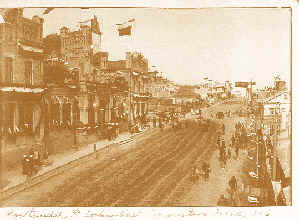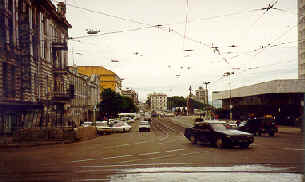VLADIVOSTOK: A HISTORIC WALKING TOUR
SVETLANSKAYA
You do not have to walk very far from Train Station Square to see the most famous sights of Vladivostok. Most of the city’s historic sites are clustered on the main street, the original name of which was Amerikanskaya (American) Street.
How this name came about is an interesting story. It was given in honor of the famous corvette the Amerika, which was built in the USA. It was among the first three ships with Russian crews to be sent on thorough mapping expeditions of the area. The Governor General of Eastern Siberia, Nikolai Muravyov-Amursky, was on board; they explored the land that is today the center of Vladivostok (1859). In 1872, the Amerika led by Rear-Admiral A. E. Crown (the Commander-in-Chief of the Ocean Ports of the East) again played an important role for the city. Laid up for three months in anticipation of the royal squadron and its high-born passenger, Tsar Alexander III's brother, Grand Duke Alexey Alexandrovich, the crew helped clear the ground of what is now Vladivostok’s principal street. They called it the Amerikanka in honor of their ship. This nickname stuck and remained in (unofficial) use for a year.
In 1873 the street was renamed for the frigate the Svetlana, aboard which the Grand Duke visited the city. Half a century later, after Vladimir Lenin’s death in 1924, Vladivostok’s main street became the “Street of Comrade Lenin,” Leninskaya for short. After hot debates and much discussion, in August 1992 the old name Svetlanskaya was restored--let us hope, forever.

AI, 1896
At the time of the Coronation
Many buildings on Svetlanskaya Street used to belong to foreign businessmen and diplomats. Although surprising for a port that was then a mere settlement, Vladivostok was given the status of “porto franco” (a “free port”) already in 1861, and this privilege remained in part until 1909. It meant that foreign-owned businesses, factories, plants, stores, and other enterprises were tax-free for several years. This is why many foreign entrepreneurs took advantage of the “porto franco” status of Vladivostok and came to settle here in order to establish their companies, corporations, and concessions.

DM, 1996
HOME / BACK / ITINERARY / CONTINUE TOUR